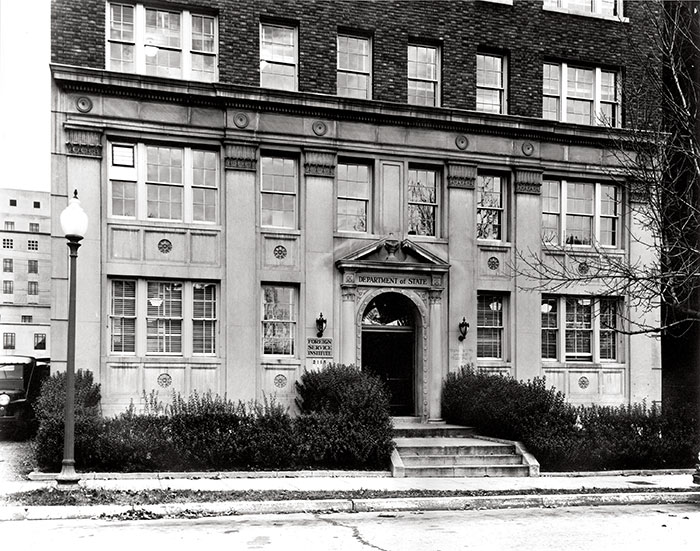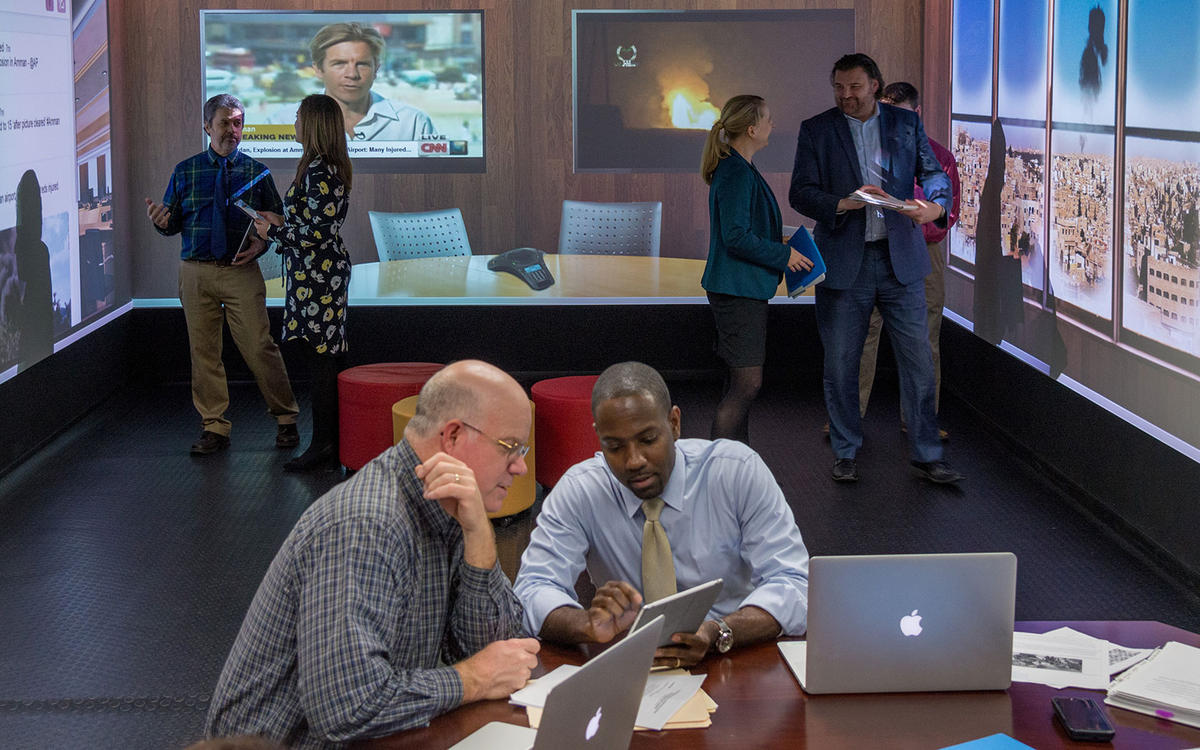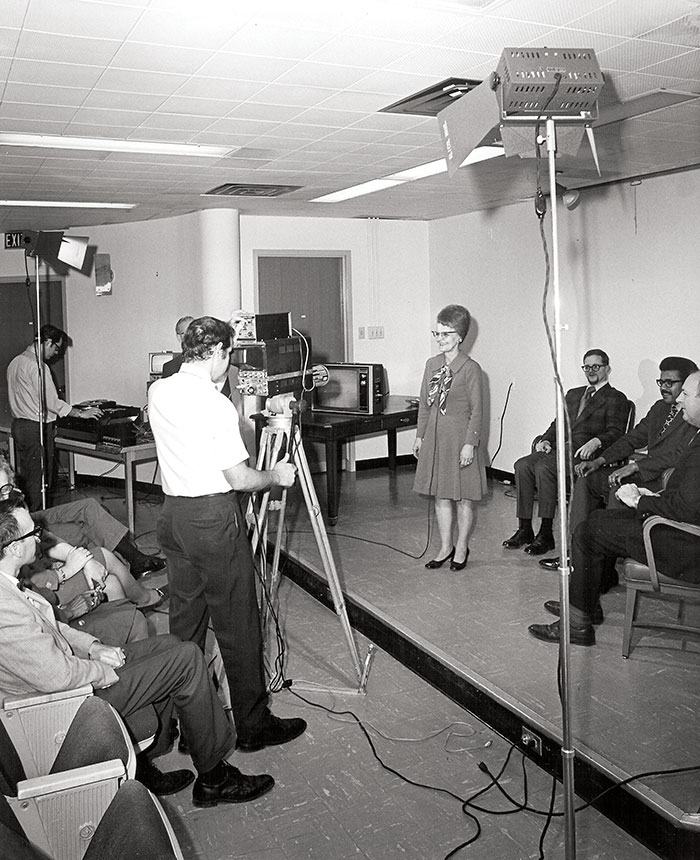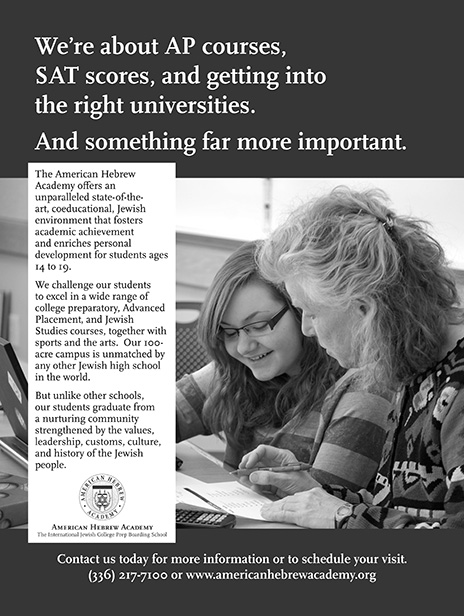The Foreign Service Institute at 70: Recalling a Proud History
Though much has changed at FSI in its 70 years of operation, its core mission remains to serve those who serve America around the world.
BY STEVEN ALAN HONLEY

The Mayfair Building, in Washington, D.C.’s Foggy Bottom, was the FSI’s original location.
U.S. Foreign Service Institute
On March 13, 1947, Secretary of State George C. Marshall issued a regulation formally establishing the Foreign Service Institute, pursuant to passage of the Foreign Service Act of 1946. But FSI actually had three precursors, starting with the Wilson Diplomatic School, State’s first professional training facility, founded in 1909. Its curriculum was not exactly rigorous; apparently, according to The New York Times, “Young men who would be ambassadors [had] nothing to do but absorb the lectures and look happy...”
Fifteen years later, the Rogers Act, also known as the Foreign Service Act of 1924, not only created the modern Foreign Service, but a Foreign Service School. On June 7, 1924, President Calvin Coolidge duly issued Executive Order 4022, establishing that facility for the purpose of training newly hired probationary Foreign Service officers.
However, the Foreign Service School principally arranged for the detail of new Foreign Service officers to divisions of the department for five or more months before their assignments abroad. It did not conduct any professional training, likely on the assumption that entrants already spoke the requisite languages and could master the necessary skills on the job.
In 1931, FSS was rebranded as the Foreign Service Officers’ Training School, and its mission was expanded to give new personnel intensive training in consular and commercial work after they completed two-year probationary tours overseas. Later, FSOTS assigned small groups of economic and commercial officers to universities for graduate studies.
By 1941, State Magazine reported that some 55 officers had completed special training at FSOTS in Arabic, Chinese, Japanese, Russian, Turkish and other languages. Just months later, however, State suspended all Foreign Service training programs for the duration of World War II.
The Foreign Service Act of 1946
Even before the end of the war, support grew rapidly within the State Department for a reorganization of the Foreign Service to prepare it for a vastly expanded portfolio. Such proposals, which would help shape the Foreign Service Act of 1946, included calls for the establishment of a permanent school for the comprehensive training of State Department personnel.
The March 1946 issue of The American Foreign Service Journal (as the FSJ was then known) summarized its understanding of the likely provisions of the new Foreign Service Act regarding training as follows: “A Foreign Service Institute will be established to give initial training to officers and employees and to provide in-Service training throughout the whole career of every member of the Service. It is planned that the director of the Institute shall receive the salary of an assistant secretary. Every effort will be made to attract to the staff the very best scholars that the universities of the country can furnish. In its higher echelon the school will be a staff college, or center of higher studies.
“Formal instruction will be given on the school premises itself, and the college will arrange for Foreign Service officers to work and consult at high levels, not only in the department but in any agency, business, research organization or university where possibilities exist for widening the background of the Foreign Service officer.”
President Harry Truman signed the Foreign Service Act on Aug. 13, 1946, and it entered into force three months later. On March 13, 1947, the Foreign Service Institute opened its doors.

Staff and students participate in a crisis simulation in the EdTech Immersive Learning Environment at FSI.
U.S. Foreign Service Institute
FSI’s Early Years
In its first incarnation, FSI was housed in the Mayfair Building at 2115 C Street NW in Washington, D.C. That was near the old War Building, which was about to become the center of State Department operations. The facility consisted of four schools: Basic Officer Training, Advanced Officer Training, Management and Administrative Training, and Language Training. In The U.S. Department of State: A Reference History (Greenwood Press, 1999), Elmer Plischke comments: “By 1949, the Institute provided an extensive menu of instruction, consisting of nearly 60 subjects and projects, of which more than 40 concentrated on management and administration topics, evidencing the need for greater technical expertise in this field.”
Impressive as that curriculum was, it did not assuage Cold War concerns about the state of American diplomatic readiness. Such worries led Secretary of State John Foster Dulles to convene a “public committee on personnel” in January 1954. Chaired by Henry Wriston, president of Brown University, the committee moved quickly, obtaining Secretary Dulles’ approval of its sweeping recommendations less than six months later.
FSI works to forge a strategic view of the future direction of the world and equip its students to navigate through it.
Wristonization, as the process of implementing the panel’s action plan became known, unfolded rapidly. Within three years the Foreign Service had more than doubled in size to 3,436 officers—an influx that placed a lot of pressure on FSI, both in terms of workload and facilities. In 1955 the Mayfair Building underwent a complete renovation, and the training program was revitalized as well, with new, shorter courses and longer specialized training. In addition, courses were opened to wives for the first time. The new program included three periods of concentrated, full-time training: for new officers, those in mid-career and senior officers. There was consistent emphasis on improving language skills.
Debate continued, however, over training needs—the amount and timing of training, who should be trained and how best to do it all. Even as FSI grew, Plischke notes, “Thought was also devoted to creating a National Academy of Foreign Affairs for more advanced training, to supplement [the] Foreign Service Institute. In 1961 a special committee submitted a report to Secretary [of State Dean] Rusk, which recommended the establishment of such an Academy for additional training at the highest level, to include instruction, research and leadership of all governmental education programs and to deal with ‘the delicate dynamic of democratic strategy.’”
Legislation was introduced in 1963 to found such an academy, but it languished in Congress following hearings in the Senate Foreign Relations Committee and was never reintroduced.
The 1960s Era

Public speaking training underway at FSI during the 1950s.
U.S. Foreign Service Institute
As the U.S. military presence in Vietnam continued to grow by leaps and bounds throughout the 1960s, so, too, did the Foreign Service presence there. By 1968, nearly every unmarried male junior FSO who had not performed active-duty military service was automatically sent to Vietnam for his first tour, whether or not he had requested the assignment.
That dramatic ramping-up of demand for Vietnamese language training seriously strained FSI’s capacity. In “The Foreign Service Institute after 20 Years” (November 1966 Department of State News Letter, No. 67), FSI Director George V. Allen acknowledged the scope of the task: “It must be remembered that classes in hard languages, for example, must be limited to six—or, in exceptional cases, eight—students each; and when we are teaching over 165 students in Vietnamese alone (at present), a lot of classrooms, a lot of language booths and a lot of teachers are required. Fortunately, he noted, “We recently brought over 20 additional Vietnamese teachers from Saigon, who have been noted for their charms as well as ability.”
The Vietnam Training Center, a separate facility, supported those FSOs who needed intensive training for their assignments. But most officers from State and the U.S. Agency for International Development, particularly those in the “lessthan- voluntary” category, took a more basic curriculum at FSI. This was essentially an abbreviated area studies program focused solely on Vietnam: its history, culture and present situation.
The VTC disbanded in the early 1970s, relieving some pressure on faculty and staff, but FSI’s leadership still faced logistical and fiscal challenges. During the 1970s and 1980s, the Institute shifted from one temporary location to another, eventually migrating from Washington, D.C., to two State Department annex buildings in Arlington, Virginia: SA-3 and SA-15.
The Big Move
In 1986, professional training once again got a new look, with new classes and a new curriculum (including, most notably, ConGen Rosslyn for consular training) that moved away from the traditional lecture-based format. Students welcomed the fresh new approach to training, but as former FSI Director Brandon Grove would acknowledge in a 1993 FSJ interview, a more fundamental problem continued to fester: “The training conditions in [Rosslyn were] just awful. An environment does not determine what you can do, but it conditions the way you do it and how you feel about your work.”
Fortunately, plans were underway by the late 1980s to relocate FSI to its current home in Arlington—which, Grove correctly predicted, “will transform the Foreign Service.” One major attraction of the new site was that Arlington Hall was designed to be a campus. Originally the home of Arlington Hall Junior College, an all-female school founded in the 1920s, the 72-acre plot later served as a U.S. Army installation. In fact, four structures dating from the early history of the site as a junior college—the yellow-brick Old Main building, the girls’ gymnasium and two historic Sears Roebuck prefabricated cottages near Route 50—have been renovated and incorporated into the current training center.
The National Foreign Affairs Training Center, the official name of the campus that now houses FSI, opened on Oct. 13, 1993. And at a May 29, 2002, ceremony, NFATC was renamed the George P. Shultz Center, in honor of the Secretary of State from 1982 to 1989, who was instrumental in its establishment.
Though much has changed at FSI in its 70 years of operation, it has never lost sight of its core mission: to serve those who serve America around the world. But in its quest to make U.S. diplomats—and, by extension, our diplomacy—the very best they can be, there is really only one path to success. It requires continual experimentation and evolution, as well as the willingness to take risks and learn from mistakes, and to strive for improvement through innovation. Underpinning it all, FSI works to forge a strategic view of the future direction of the world and equip its students to navigate through it.
If FSI’s first seven decades are any indication, it is up to the challenge.
FSI’s Main Components Today
The School of Language Studies. Foreign language proficiency has historically been one of the strong points of the Foreign Service, and a distinguishing trademark of American diplomats around the world.
The School of Language Training, as this division of FSI was originally designated in 1947, went through a series of name changes during its first two decades. It was almost immediately renamed the Language Training Branch; then, in 1955, the School of Languages; and shortly after that, the School of Language and Area Studies. In 1966, Area Studies moved to the School of Professional Studies, and the School of Language Studies has stood on its own ever since.
In its first year, SLS taught 31 languages to 559 students, delivering 34,361 hours of instruction. The largest language programs were in French, German, Spanish, Russian and Arabic. The Arabic course lasted six months, making it the longest program. Teachers were known as Native Informants, while language training supervisors were called Scientific Linguists.
From the beginning, FSI has utilized state-of-the-art technology to facilitate learning. Under its first director, Henry Smith Jr., the School of Language Training incorporated intensive methods of language instruction that only the armed forces used at the time. Smith acquired $10,000 worth of basic manuals and phonograph records from the U.S. Army, and invested $30,000 more in record players, SoundScriber tape recording machines and other equipment.
The School of Language Studies is a co-creator of the speaking and reading language proficiency rating scales (0-5) used throughout the U.S. government, and a leader within the U.S. government’s interagency community of language trainers and testers. It currently offers instruction in more than 70 languages, with course length and curricula targeted at a range of language proficiencies from basic to advanced. In 2015 the School of Language Studies delivered 1,659,190 hours of language training.
In addition to training in Arlington, Virginia, advanced language instruction is provided at field schools in Seoul, Taipei and Yokohama, and via regional programs in the Middle East and North Africa, as well as in China and Mexico City.
The School of Professional and Area Studies. When FSI opened, a division known as the Specialized Training Branch administered all of what today we would call professional tradecraft courses. In 1955 its name changed to the School of International Studies; then, less than two years later, to the School of Foreign Affairs. In 1966 the title was changed yet again to the School of Professional Studies, after FSI management decided to center all functional and substantive curricula there. FSI eventually merged the Area Studies program into the School of Professional Studies, where it has remained ever since.
The School of Professional and Area Studies conducts job-specific orientation, tradecraft and area studies training to empower foreign affairs professionals to advance U.S. interests and tackle the evolving challenges of 21st-century diplomacy. Toward that end, SPAS offers tailored programs in consular, economic and commercial work; management and office management; and political and public diplomacy, as well as new-hire orientation programs and in-depth area studies courses.
SPAS currently encompasses 10 divisions: Area Studies, Office Management Training, Consular Training, Orientation, Curriculum and Staff Development, Political Training, Economic and Commercial Studies, Public Diplomacy, Management Tradecraft and the Center for the Study of the Conduct of Diplomacy.
The School of Applied Information Technology. FSI has long prided itself on being a catalyst for the evolution of U.S. diplomacy to meet new challenges and apply new tools. A vivid example of this approach is the School of Applied Information Technology, founded in 1996, which prepares Department of State employees for their foreign affairs mission by developing proficiency in the use of technology.
Specifically, SAIT enables end-users to efficiently and effectively weave technology into their daily routines; ensures that the department’s information technology professionals have the up-to-date knowledge and skills required to operate and maintain the complex computer and technology systems employed domestically and at all U.S. overseas missions; and prepares individuals to serve as IT consultants on behalf of their missions.
SAIT has three divisions: Enterprise Technology; Research, Learning and Development; and Business Applications. On average, SAIT provides training to more than 6,000 students annually, both overseas and domestically, through classroom and blended-learning opportunities in Arlington, Virginia; at FSI’s Regional Training Centers in Fort Lauderdale, Frankfurt, Johannesburg, Manila and Bangkok (that serve all of FSI’s divisions); and via 21 adjunct faculty instructors in 16 countries around the world.
The School of Leadership and Management. The State Department’s emphasis on leadership and management training is closely associated with former Secretary of State Colin Powell, who frequently cited the importance of training for his own military career. However, FSI actually founded the Leadership and Management School in 1999, two years before Powell arrived in Foggy Bottom.
The School’s core leadership training series consists of mandatory basic, intermediate and advanced courses, as well as the Senior Executive Threshold Seminar for people newly promoted to the Senior Civil Executive Service and Senior Foreign Service. About 6,000 employees a year take at least one of those courses.
These are complemented by some 10 electives that focus on specific leadership skills, traits and behaviors. In addition, coverage of leadership and management principles is embedded in the various professional tradecraft courses.
LMS also offers a tailored crisis management training program for the United States’ 270 diplomatic posts abroad, sending a team to more than half of them each year; individualized coaching services; and organizational development services to missions, bureaus and other units.
The Transition Center. The office that began operations more than 40 years ago as the Overseas Briefing Center is still going strong today as the nucleus of FSI’s multifaceted Transition Center, which serves all U.S. government employees of foreign affairs agencies and their family members preparing for, or returning from, overseas assignments.
The Transition Center offers formal courses and programs, as well as non-tuition seminars, briefings and resource fairs—all designed to meet the diverse needs of the foreign affairs community as its members navigate a transitory lifestyle.
In addition, the Center conducts retirement planning workshops, and assists personnel returning from Iraq, Afghanistan and other high-threat assignments through its High-Stress Assignment Outbrief Program. Other TC programs include Security Training; a Career Transition Center; and the new Center of Excellence in Foreign Affairs Resilience, designed to help individuals, family members and teams perform at their best, even in high-stress, high-threat environments.
—Steven Alan Honley











